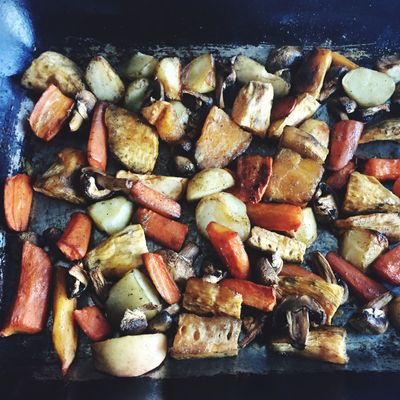
Over Easy is a weekly food column by a 20-something woman who can barely cook an egg and just wants to learn how to throw together an elegant three-course meal for her friends.
Roasted vegetables sound so easy. “Oh, us?” they seem to say. “Just toss us in some olive oil and salt, bake us for a bit, and we’re good to go. Or don’t, you know, it’s up to you. We’re good with whatever!”
Wow, you think, that does sound easy! And who doesn’t love roasted vegetables? They taste better than regular vegetables because they’re crispy and covered in oil, and they have the sort of rustic, casual elegance about them that makes them a relaxed but still impressive side dish (if done correctly) for an intimate dinner with friends and frenemies. So you cut them up, arrange them in nice, orderly lines on a baking sheet, and stick them in the oven. But in my experience, that’s when the seemingly demure produce develops a mind of its own, and everything goes to Hell.
“Just kidding!” the vegetables screech from their fiery depths. “We’re complicated and have very specific needs and we hate you and you’re stupid and now half of us are ash and half of us are mush and your apartment is filled with smoke! Ahaahaha!”
I had a recent encounter with roasted vegetables a few weeks ago, when I tried to make a roasted summer vegetable galette and set my fire alarm off twice. As you can see from the picture below, it was not a success, and I am lucky my apartment is still standing.
Frustrated, I decided I had to try to master roasted vegetables once and for all.
Though I’d roasted-slash-burnt vegetables before, I’d never actually read about proper technique. After some brief Googling, I found two articles that seemed particularly helpful. This one by Emma Christensen at the Kitchn outlines which vegetables to roast together, and how long (root vegetables like carrots and potatoes roast for 30 to 35 minutes, soft vegetables like eggplant and zucchini for 10 to 20), and this one from Molly Baz at Bon Appétit suggests a “Weird Trick to Nailing Roasted Vegetables Every Time” (cooking them on your oven floor, where the heat comes from, so they get an “immediate hard sear”).
Both recipes recommend preheating your oven to over 400 degrees, though, as Sarah Jampel wrote about at Food52, there is a case to be made for roasting your vegetables long and low at 250 degrees, and I would recommend checking out her in-depth investigation to see which temperature is best for you. Personally, although using the phrase “long and low” makes me feel like an old, wise grill master, I decided to stick to “fast and high” because I am young, unwise, and impatient.
I started by cutting up and roasting sturdier vegetables — a potato, beet, and sweet potato — so I could try Baz’s oven-floor method which she says works best on “vegetables that can take an aggressive sear.” Baz stresses the importance of cutting vegetables into equal-sized pieces so they cook evenly. This caused me far more anxiety than it needed to, and I got so in my own head that I developed a brief case of size-blindness that really slowed me down and even prompted me to pull out a ruler and make sure I was cutting the vegetables into roughly half-inch segments.
After tossing the vegetable bits in olive oil, I seasoned them with salt and pepper, and laid them out on our two cake pans, because our apartment’s one baking sheet has gone missing and no one knows where it is. (If you have any knowledge of its whereabouts, please contact me.) When the oven was heated to 450 degrees, I placed the two cake pans on the floor, waited 10 minutes, and then opened the oven door to toss the vegetables. Here’s where things went off the rails.
While mixing around the potatoes and beets, one small, courageous potato bit made a wild bid for freedom, leaping out of the cake pan, skidding across the bottom of the oven, and plunging into the side vent where the heating element lives.
I swore repeatedly, and hoped that maybe, just maybe, this wouldn’t affect my cooking, and that the stray potato wouldn’t immediately burst into flames and I could keep on roasting my vegetables (Baz doesn’t have a recommended cook time, but she suggests checking on the vegetables every five minutes until they are “just al dente”). But of course, that’s not quite what happened. I closed the door, and three minutes later, a sharp burning smell filled my apartment. Smoke began escaping out of the sides of the door.
I yanked the cake pans out and turned the oven off and swung a dish towel around. Feeling very annoyed and sorry for myself, I forked one piece of potato and took a sad bite only to find that it was … not bad! None of the vegetables were. The beets were still a little soft, and could have used more time, but the sweet potatoes and potatoes were crispy on the outside and warm and soft on the inside. I was so delighted by this happy mistake that for a moment I forgot that I would have to fish the potato bit out of the bottom of the oven so it didn’t smoke up every time I tried to cook something. When I remembered, I swore some more, and because the oven was still too hot to dig around in, wrote myself a reminder on our whiteboard that I hoped my roommates would be too busy to notice.
The next day was deflating. The potatoes were now cold and soggy, supporting my hypothesis that roasted vegetables must be consumed in their first hour out of the oven. Plus, I had to find a way to make my oven usable again.
After tugging ineffectively at the oven floor for a couple of minutes, I noticed the screws holding it in place and went to get a tool kit. The only one in our apartment is Pepto-Bismol pink and mostly still wrapped and feels kind of like a step backward, women’s equality-wise, but it works. Mumbling “righty tighty, lefty loosy,” under my breath, I successfully removed the oven floor, found the offending potato bit, and then screwed everything back into place. I was sweaty, but proud.
Still, I didn’t feel like I had learned how to successfully roast. The potatoes were simply a lucky accident. So I tried again with soft vegetables, a zucchini, eggplant, and yellow squash.
After cutting them up and tossing them in oil, I put them in the middle rack on the oven (I didn’t know if they were sturdy enough for Molly Baz’s hard sear) at 425 degrees, as Emma Christensen at the Kitchn recommends. After ten minutes, I opened the oven to turn them, and things didn’t look good.
The vegetables were all soft, and there wasn’t much of a sear on them. I waited five minutes, turned them once more, waited five minutes again, and then, since it was the end of Christensen’s suggested cook time, took them out. The vegetables sucked. They were mushy and oily and smoky but in a burnt kind of a way, not a pleasant way. What the hell?! They were worse than vegetables I’ve roasted before. Did I cut them too big? Did I turn them too often? Not enough?
I don’t know, and I would like three more weeks of concentrated study to figure it out. But alas, I am on a deadline, and also I need some time and space to stop feeling angry at and betrayed by vegetables. On the bright side, I know a lot more about the inside of my oven now.
My report card
Preparation: D? (I assume I did something wrong but what?)
Taste: D
Understanding the inner workings of my oven: B+
My Overall Performance: D+




